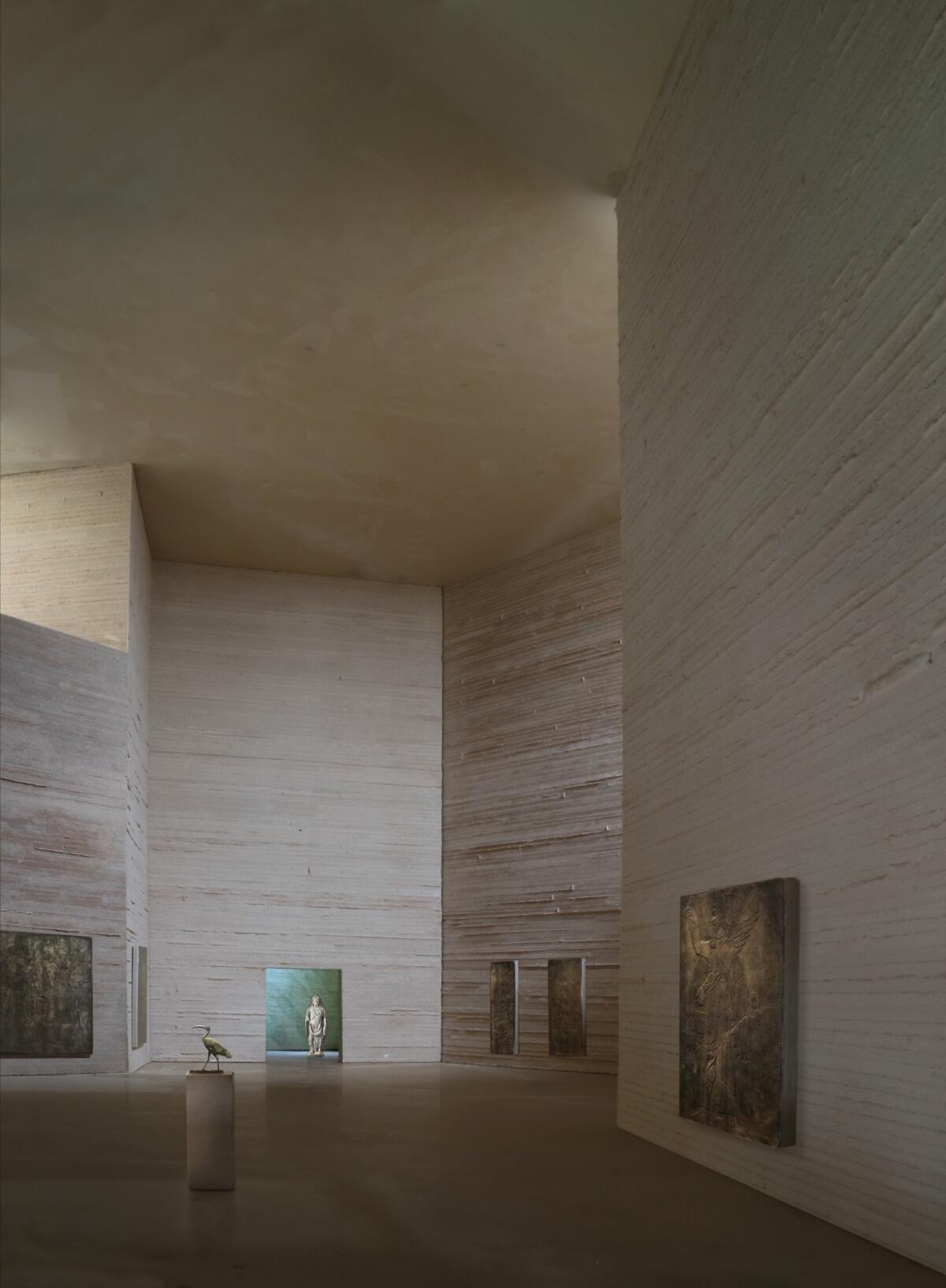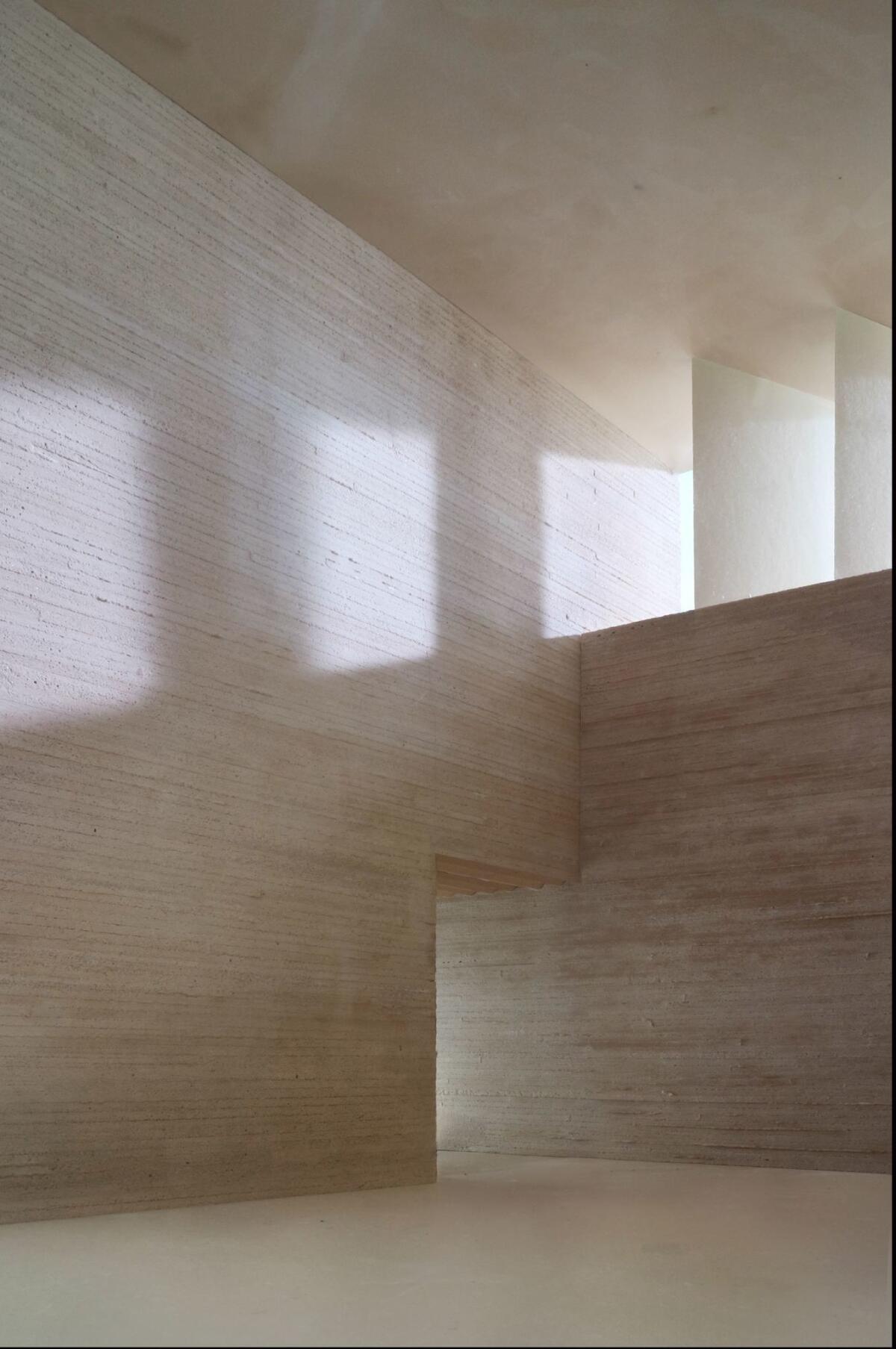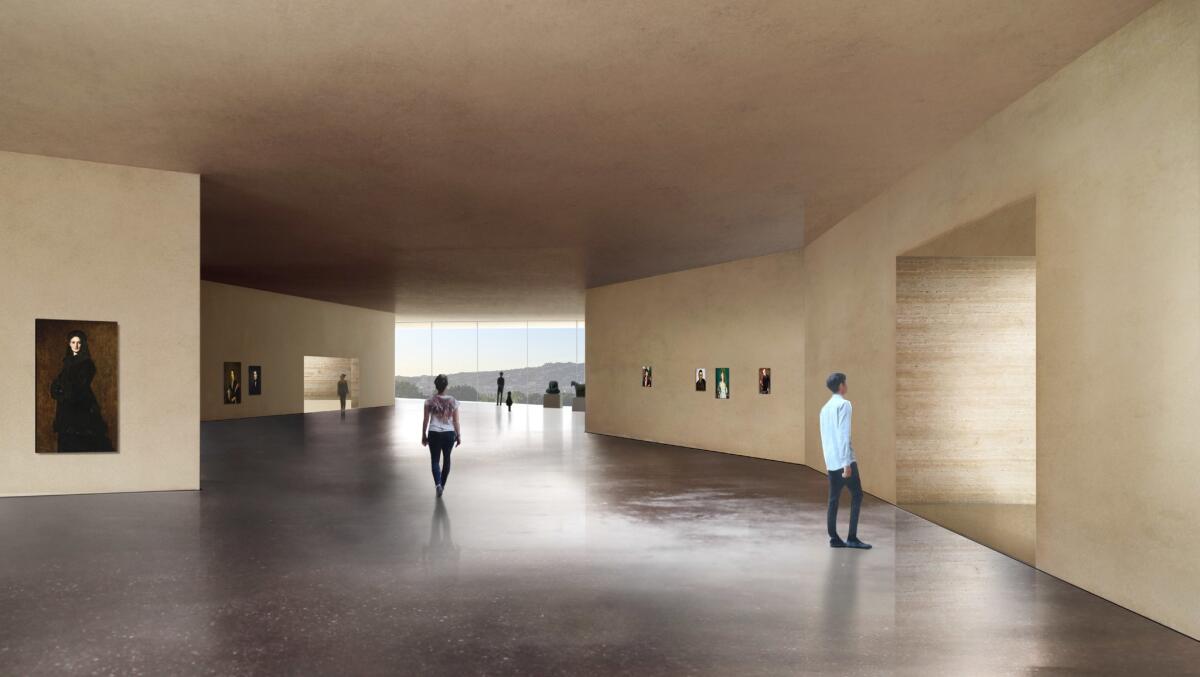The new LACMA: Plans call for radical change to how we see the permanent collection
- Share via
For nearly eight years, the
Repeal and replace, so to speak. Groundbreaking is planned for next year.
Models have been made, displayed, scrapped and remade. Millions have been spent, controversies have flared, significant design changes — slow in coming — have been unveiled. Response has been contentious.
Yet, most public attention has focused on the architecture. What Zumthor is designing, however, is not a discrete object. It won’t simply be a building to experience. And for the art public, the architecture might turn out to be the least of it.
The program for the new S-shaped structure spanning Wilshire is to house the museum’s paintings, sculptures, design objects, photographs and other art — an encyclopedic collection that sprawls across continents and centuries. In its new home, expect LACMA’s permanent collection to break all the rules. The permanent collection won’t exactly be permanent.
LACMA instead plans to install the collection as a continuing series of temporary exhibitions — cross-cultural and interdisciplinary. An impermanent permanent collection, the scheme is unprecedented.
Recently, I sat down with the museum’s director, Michael Govan, for a lengthy conversation about his plan. What he has in mind is radical and risky; if Govan pulls it off, it could dramatically change the way other museums’ encyclopedic art collections are viewed.
Regular loan shows will of course continue in the Resnick Pavilion. But the permanent-collection plan is wide open, limited only to curatorial imagination. I made up examples for illustration:
One suite of galleries might assemble art from around the world whose subject is mortality and function is valedictory. Another might be only art made in colonial societies south of the equator.
A third could consider artists’ use of light as material and metaphor. A fourth might focus on a conventional art historical category — the Dutch Golden Age, say, or painted ceramics from ancient western Mexico. A fifth could be as simple as “Animals.”
Who knows? Maybe one gallery would be arranged by color — say, objects that are mostly red.
In LACMA’s plan, each temporary exhibition will be of a different duration — one on view for a year, another perhaps for five. If shows require important objects from another museum’s collection to make critical points, long-term loans will be sought.
Collection-sharing won’t just be sought between museums. Curators in one LACMA department will have access to works in other departments, which more often function as independent fiefdoms. An especially successful show might be packaged to travel to art museums elsewhere.
The plan’s most intriguing feature is how it upends our established idea of an art museum as a place to discover history.
Since the dawn of a new millennium, many museums, including LACMA, have been experimenting with permanent collections. A temporary one-room permanent collection installation in 2013 juxtaposed 19th century American landscape paintings and photographs that revealed startling visual shifts from new technology. The Italian Baroque gallery now includes Greek vases and Roman antiquities to show how ancient art had a profound effect on 17th century artists, while works by Swiss and German painters demonstrate how Rome was an essential destination for international artists.
Hints of what’s to come, these differ from typical museum collections that are laid out spatially by strict chronology and limited geography. Relatively static, such rooms change as new works are acquired and historical ideas are revised, but changes are usually incremental. Wholesale revisions are rare.
Usually, encyclopedic permanent collection displays favor history. New York’s Metropolitan Museum of Art is the American template. Enter its Great Hall and over to the right is ancient Egypt, over to the left is ancient Greece and Rome, and dead ahead are the Middle Ages.
Above them rises a grand staircase. Ascend to the top: Europe!
Art from Asia, Africa, the Middle East and the Americas is of course present, often in splendid ways. But those galleries are off to the side, secondary on the floor plan if not in artistic quality or spirit.
This traditional organization reflects a specific legacy. The art museum idea was born of the European Enlightenment, which emerged in the 18th century from epic, often brutal colonial adventuring around the world. LACMA, like the Met, is currently organized along those lines.
A new LACMA tosses all that by the wayside. No chronology, no geography — except in incidental ways.

The plan’s most intriguing feature is how it upends our established idea of an art museum as a place to discover history. Paintings, sculptures, photographs and other works of art are most often seen as documents of the past. A proudly prancing horse in brightly glazed ceramic from a Chinese burial tomb shows us a Tang Dynasty world view, while values in 17th century West Africa are illuminated by a finely wrought bronze plaque of a Benin tribal official.
By contrast, in Zumthor’s building, the past becomes the present. The horse and the plaque get presented as living, breathing, contemporary art.
This is not as outlandish as it might at first seem to be — or even as reformist.
Any work of art, regardless of when and where it was made, is still busily chatting away to viewers in the moment they are perceiving it. The monumental dignity of the African American women who dominate Winslow Homer’s 1876 composition in “The Cotton Pickers” is undiminished — and even patently current.
As T.S. Eliot put it nearly a century ago, the historical sense “involves a perception, not only of the pastness of the past, but of its presence.” The eloquence with which an older art object illuminates experience today is a measure of its greatness.
The Enlightenment structured historical knowledge into an encyclopedia, and it consolidated historical paintings and sculptures into encyclopedic art collections. The new LACMA sets that approach aside, instead privileging the present.
How very L.A.
A clue to the pending switch came in 2013, when the initial version of Zumthor’s design was unveiled in a summer exhibition. Its title was pure Eliot: “The Presence of the Past.”
Even earlier, in 2008, artist Jorge Pardo and Virginia Fields, the late curator of art of the ancient Americas, transformed the museum’s pre-Columbian display. Undulating casework, taffeta curtains, eccentric chandeliers (like exotic jungle plants) and a lively palette of lime green, sandy brown, citrus orange and other bright colors created visual intensity.
Some visitors hate it — I’m a fan — but the admirable goal is to reanimate objects from a lost time and place. What makes the new building’s planned scheme valuable is that it favors an egalitarian, post-colonial point of view.
For his part, Zumthor has almost no experience designing for encyclopedic collections. He has built two relatively modest art museums: the 1997 Kunsthaus Bregenz, a contemporary art museum in a small Austrian city, and the 2007 Kolumba Museum, which houses the eclectic collection of art and artifacts held by the Archdiocese of Cologne, Germany. Both have been well received.
His new LACMA building is expected to feature seven interior gallery pavilions; wide corridors around and between them have been dubbed “meander galleries.” Curators have grumbled that they’ve pretty much been left out of the Minimalist architecture’s planning. Apparently, their input was deemed less than necessary because the architect is designing atmospheric spaces, with which staff may do as they please.
Zumthor’s design does create practical problems. Gallery walls will be concrete, which seriously complicates hanging art. (Earthquake safety prevents suspending paintings from wires, as Victorians once did.) Ambient side-illumination from glass perimeter walls and clerestory windows makes lighting art difficult. And 30-foot ceilings can’t easily accommodate artificial lighting systems.
Other questions linger.

Since a convincing permanent collection show might require a pivotal loan from another museum, would a museum elsewhere really let go of a critical masterwork for a few years? Would LACMA return the favor to honor reciprocity?
Its current 393,000 square feet of existing buildings will shrink by 25,000 square feet — perhaps the only example of an expensive building project designed to reduce museum space rather than expand it. (Govan asserts that it’s because curatorial offices and other support areas are left out, with staff to be housed in rented offices in the skyscraper next door.) Yet future museum expansion is inevitable, since collections will continue to grow, while Zumthor’s self-contained design cannot be enlarged.
Satellite buildings are the only foreseeable solution to an eventual space-crunch. Is that really a promising idea?
The most worrisome risk is more abstract, but nonetheless powerful. It goes to the way an art public develops a deep museum bond.
Right now, I know exactly where to go on the Ahmanson Building’s third floor to see Rembrandt’s “The Raising of Lazarus” and Hendrik Goltzius’ “The Sleeping Danae Being Prepared to Receive Jupiter,” two of my favorites in LACMA’s collection. (Ditto Pontormo’s “Portrait of a Halberdier” at the Getty, Watteau’s “Reclining Nude” at the Norton Simon and Velázquez’s “Juan de Pareja” at the Met.) In the new scheme, both would probably still be on view, given their importance, but who knows where or how?
An art public falls in love with works of art first, then transfers that affection to the museum that cares for them. For that, permanent beats temporary. But LACMA’s new scheme asks us to turn things around — to love the museum first, and only then to be excited to see what it does with art. Perhaps I speak for a minority, but falling in love with an institution is hard to do.
At LACMA (as at the Met and most everywhere else), permanent collection galleries generally see less traffic than special exhibitions do. Picasso’s great 1937 “Weeping Woman With Handkerchief” hangs quietly on the Ahmanson Building’s second floor every day, but put the same painting in a special Picasso exhibition and odds are you won’t be able to get near it. The idea of turning the permanent collection into a compendium of temporary shows attempts to solve a problem of underutilized assets.
But is that a real problem, or just a solution in search of one? Boards of trustees gauge success on attendance figures, because boards are mostly business people who lean toward quantifiable data. But quantity of experience is no substitute for quality of experience.

The big risk for LACMA’s plan is how it changes our relationship to art we love — and through it, our relationship to the museum. Busting up a colonial-era organizing structure is worthy, but to achieve it, maybe the collection’s important art should just be lined up chronologically in the new galleries. Put the oldest work first, the newest last. Done.
Stand a colossal marble head by Florentine artist Baccio Bandinelli next to an ethereal Korean scroll of water buffaloes in ink washes on delicate silk. Then juxtapose them both with the incomparable Ardabil Carpet, a paradise garden woven in wool and silk in Shiite Persia and signed by the mysterious Maqsud Kashani. We’ve never seen the 16th century displayed like this.
That would be the ultimate in Minimalist organization. Who knows if it would satisfy. It might produce visual chaos, but at least I’d always know exactly where to find the Rembrandt and the Goltzius.
christopher.knight@latimes.com
Twitter: @KnightLAT
♦ ♦ ♦ ♦ ♦ ♦ ♦ ♦ ♦ ♦
Share your favorites
Do you have a favorite museum artwork that you seek out time and time again, like visiting an old friend? Tell us the artwork and the museum by email for a follow-up article. Include an explanation if you want: calendar@latimes.com
MORE MUSEUM COVERAGE:
Here are the latest designs for LACMA's $600-million makeover
LACMA's latest additions: Acquisitions to the permanent collection, in pictures
New Marciano foundation proves the potential and the pitfalls of a vanity art museum
The biggest entertainment stories
Get our big stories about Hollywood, film, television, music, arts, culture and more right in your inbox as soon as they publish.
You may occasionally receive promotional content from the Los Angeles Times.








